The growth of the village attracted the attention of businessmen and in 1926 one more link with the past was broken, when the mill ceased to be a flour mill. The larger mills being used then had made it impossible for small ones to pay their way. Thus the mill was sold and eventually reopened as theWindscreen and Cabinet Making Factory still in occupation.
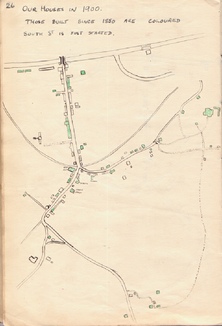
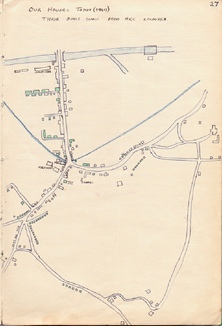
The present building, which is at least the third to have been built there, was erected in 1865 after its predecessor had been burnt down. The owner in those days lived in the Mill House opposite, on the gardens between the Clockhouse and number 2 Roydon Road. This attractive old house was pulled down later on when the Metropolitan Water Board acquired the land. The Mill Stream has since been run through pipes and the whole corner widened. For 30 or 40 years rival Mills stood on either side of the Millstream for a fine windmill stood out where Glenmire Terrace now is. In fact, the houses alongside the stream are the windmill and and its adjoining storehouses converted into dwelling houses, this conversion having been carried out shortly after 1900. Incidentally, another case where conversion was carried out is The Abbott’s House (Fernside) which was originally three cottages. Thele Farmhouse two has been much added to and the original two old cottages on to which the main house was built can still be seen forming the back of the house.
Contemporary with the Mill becoming a “glass factory” as it is so often called, is the transport concern which Messrs Rankin developed at the further end of South Street. This, in common with most firms of its kind, has now become a part of the Nationalised Transport.
Improvements seem to have followed fashions about every decade and the years 1930 to 1939 saw various shops brought up to date and a branch of the EHCS opened. One of the greatest improvements is to be seen at the Pied Bull corner, which previous to being widened to its present spaciousness, was a very sharp, blind and dangerous corner, Cappell Lane being entered by a narrow high fenced bridge. This decade brought to the village mains water and electric lights cables, enabling many property owners to modernize their houses. One person specially thankful for this must have been the school caretaker who no longer needed to pump everyday enough water for the needs of 200 thirsty children.
Stage coaches having given way to the motor car, this decade also saw the first buses serving the district and many will remember the somewhat ramshackle 18 – 20 seater People’s buses which ran from Hertford via St Margaret’s to Waltham Cross. It was not until after 1930 when the LPTP took over the growing bus services that this company disappeared and the present services were gradually introduced.
The two wars took toll of our village as of all places, and the 1914 to 1918 war memorial in St Andrews church yard, records the names of 35 men who died in that war and of 14 who were killed in the 1939 to 1945 war. Bombs falling in the parish during the latter war were plentiful but luckily none hit houses. In fact, few fell near the actual village and only two did damage to property, no one being injured. Aflying bomb falling near St James’ church caused damage to the roof, ceiling and windows but fortunately none of the stained glass windows suffered. When the damage was repaired, it was decided that it was not practicable to replace the plaster ceiling and the boards have been cleared and left bare – a permanent reminder of the war. During the repairing, it was decided to fill a crack in the floor and before doing this it was found that the crack lead to a vault which, however, only contained a box full of teeth.
With this account nearing its close, a few facts relating to the more recent story of the church and the school may be of interest. The school which was so proudly shown in its early days was in 1940 officially condemned and a new school suggested. So far, numerous sites have been suggested, viewed and rejected. Meanwhile the church asked the county council to take over the school and it became a controlled school in 1947. This change lead to many long needed works being effected – roofs were retiled in the worst spots, the interior received its first thorough redecoration for 24 years, floors were patched and lavatories provided with new doors. Those days saw more children being taught in the school than ever before, for evacuation brought 152 boys and girls from London followed two years later by 119 from Hastings. By utilizing the parish hall, parish rooms and the chapel room over 300 children were accommodated at once. This event has had as much influence on recent changes as any other single happening for our children met an influence at close quarters which had never been experienced before. The quicker minded city children taught our children much and the results of this remain to be seen. One result has undoubtedly been seen in the improved results on the sports fields. Previously the school football team, even in its best seasons had always occupied bottom place;now the team holds its own very well and this is at least in part due to loss of the country boy’s natural slowness– a change which can undoubtedly be traced to contact with the more lively city children. Even more recently a further influence has begun to arrive with the coming to the new housing estate of families from South Wales and Liverpool but it is too soon yet to attempt to assess any effects. One other great asset has been the school canteen which was opened in 1943 and has fed an average of just over 100 children daily.
St Andrews church has inspired just such generosity as did St James’s in former years and since 1900 an organ has been provided, an electric blower fitted (the latter in 1939 at a cost of £50 2 8), and as recently as this year, electric light has been added. Heating caused anxiety the boiler cracking, and in 1938 gas heaters were introduced but proved rather poor. A new boiler, just given, should improve conditions on cold Sundays.
The introduction of electricity came at just the right time for the War Memorial committee who promptly placed an electrically wound clock in the tower, over £200 having been collected for the purpose.
Newcomers to the village always remark on the large number of Public Houses there are. This is actually in keeping with the amount of malting and brewing that is done in the district. Even so, old inhabitants can recall hearing of the Salmon which stood near the entrance to Easneye until it was pulled down. In addition No 1 Roydon Road and the Millhouse opposite were both at one time public houses while the Court Beron books of 1742 to 1792 frequently mention the Griffin but no one can say where it stood.
Finally, one unwelcome event of 1947 must be noted. Following heavy snowfalls lasting many weeks there came a quick thaw and the High Street and its side turnings were flooded to a depth of 3 to 4 feet for the weekend. The parish hall housed 30 people, some remaining there nearly a month while their homes were drying. This was a depressing contrast to the days in 1895 when the river froze so solidly that two people skated by moonlight at two successive full moons as far as Ware and back.
In order to complete this account, part 1 gives the picture of our village as it is today enabling readers to see for themselves the pattern which has emerged from the many events which have combined to produce the homes and times in which we ourselves live.
A brief date chart is on the last page, but space did not suffice to include the list of vicars. This, complete from 1326, can be found in the church.
PS since the above was completed, the Hertfordshire Mercury of Friday Dec 9th published the news that all Charities in education in Herts are being taken over by an Educational Foundation. Thus the Baesh charity £20 will be used for the good of education in the county.
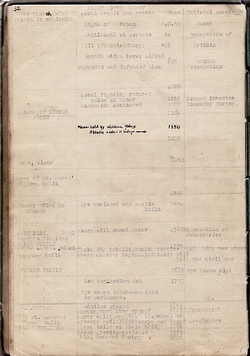
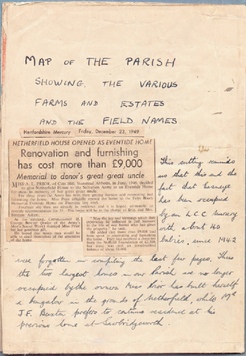
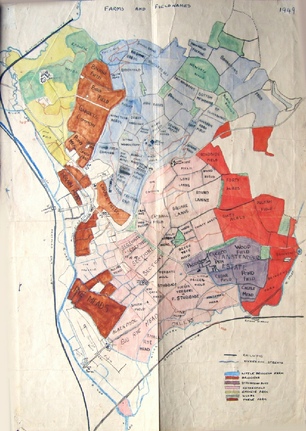
END. Copied and compiled by Rob Gifford
2018